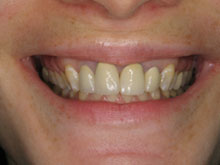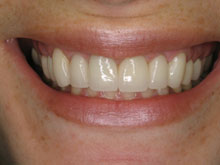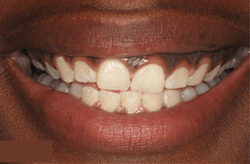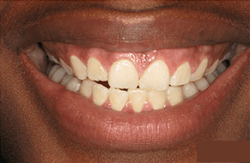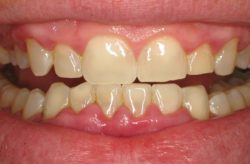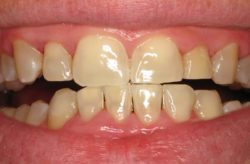ARESTIN Antibiotics in Dentistry: What Is It?
ARESTIN is a particular Tetracycline-type antibiotic used in scaling and root planing procedures (SRP) to treat periodontitis or gum disease. After a scaling and root planing procedure, the periodontal antibiotic is injected into the gum pockets to help fight harmful bacteria for an extended period of time.
Considered the best antibiotic for periodontitis, Arestin is typically in a dry powder form and comes in ready-to-use single-dose cartridges that do not require pre-measuring or pre-mixing. They are administered with a stainless steel dispensing mechanism specifically designed.
Arestin immediately bio-adheres and gradually bio-resorbs over time, so removal is unnecessary. During an Arestin treatment, a new cartridge is used for each periodontal pocket. Therefore, the number of cartridges needed depends on the size, shape, and number of pockets that require treatment.
When To Use Arestin?
Arestin is used for periodontal antibiotic treatment. It is used in fighting gum diseases in conditions where only scaling and root planing would not affect. Therefore, this antibiotic is used with scaling and root planing to combat periodontitis more efficiently.
If left untreated, periodontal infections can contribute to increasing pocket depth. Scaling and root planing alone may not be able to achieve and maintain a healthier bacteria balance. It may be difficult to access deep-seated bacteria with a scale, a handheld dental tool used to scrape, probe, and poke at your teeth. Any harmful bacteria left behind tend to recolonize quickly, potentially returning to baseline levels after some days.
This is why our specialists recommend a comprehensive and personalized treatment plan. These may include scaling, root planing, and a locally administered arestin dental antibiotic or other Tetracyclines. Additionally, other gum infection antibiotics like Clindamycin or Azithromycin can be used.
How Does Arestin Work?
Arestin for gums provides sustained-release Minocycline, a broad-spectrum Tetracycline antibiotic. Arestin starts as a fine powder, making it easy to deposit at the base of periodontal pockets. Once inserted and it has contact with gingival crevicular fluid collected from periodontal tissues, it begins to hydrolyze in the microspheres.
As hydrolyzation continues, water-filled channels form inside the microspheres. The Minocycline inside gradually dissolves and diffuses into the surrounding tissues through these channels. This helps achieve and maintain a therapeutic level of minocycline well above what is required to kill periodontal pathogens.
It can remain active in the periodontal pocket for 14 days. It will leave behind a healthier balance of bacteria and a reduction in pocket depth than with scaling and root planing alone.
FAQ
-
What is Arestin used for?
Arestin is used in gums antibiotic treatment combined with scaling and root planing for combating gum diseases that have left deep pockets of damage at the base of the teeth. For the treatment of adult periodontitis, clinical studies have shown that Arestin periodontal treatment helps achieve more significant pocket depth reduction than SRP alone. Arestin works differently than other treatments with its microsphere delivery system.
-
When to use Arestin?
Arestin is used when there is a chronic gum disease where bacteria has infected the periodontal part of the teeth. It is used when scaling, and root planing alone will not eradicate the bacteria, and a dental antibiotic injection is needed to a provide a sustained result.
-
How long does Arestin stay in your system?
Arestin antibiotics for gums can remain active in the periodontal pocket at the base of the teeth for up to 14 days. However, the Arestin compound will completely dissolve over time. Therefore, removal is not needed.

